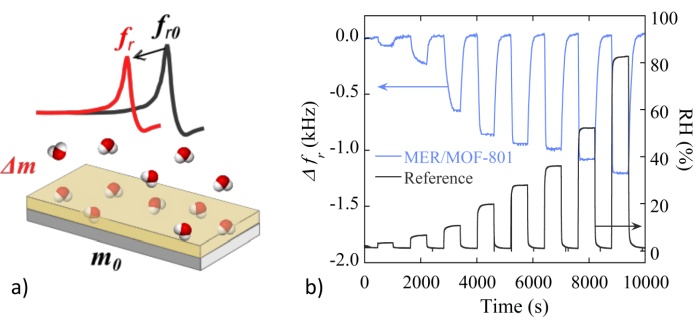Speaker
Description
Among other gases, the detection of relative humidity (RH) is crucial in air quality monitoring, food storage or industrial processes control. We present here a wireless humidity sensor based on the magnetoelastic resonance (MER) phenomenon. MER sensors are usually made of magnetostrictive ribbons, which can be driven to mechanical resonance via magnetic field excitation. The basis of their operation is the high sensitivity of their resonance frequency ($f_r$) to different factors, such as the changes in the resonator mass: $\Delta f_r/f_{r0}= -\Delta m/2m_0$ [1]. As their excitation and detection are conducted magnetically, they result especially interesting for remotely detect humidity in closed or inaccessible environments. To provide the MER sensors with water absorption capacity (mass gain $\Delta m$, and thus a detectable change in $f_r$), we propose their functionalization with active layers of water-adsorbent Metal-Organic Framework (MOF) materials (Figure 1a) [2]. MOFs are built by metal ions and organic ligands assembled in 3-dimensional structures, and stand out among the adsorbent materials because of their high porosity, great surface area, tunable pore volume, and tailored selectivity.
Five MOFs with different water-adsorption behavior were synthetized: MOF-801, MOF-808, UiO-66-NH2, Al-Fumarate and CAU-23, and then deposited on the resonator (Fe$_{73}$Cr$_{5}$Si$_{10}$B$_{12}$) surface by spray coating technique. The response of the functionalized sensor (MER resonator + MOF coating) to different levels of humidity was assessed over controlled N$_{2}$/H$_{2}$O flows. The tested MOFs showed promising water harvesting capacity, enabling a successful sensor response to humidity cycles in a wide RH range: 3-85 $\%$ (Figure 1b). MOF water absorption capacity and overall performance of the MER/MOF sensors (sensitivity, stability and selectivity to water molecules) were evaluated. The response time of the devices was about 15 seconds, with stabilization and recovery times in adsorption and desorption processes of less than 1 minute for certain RH ranges. In addition to their solid performance as gas sensors, in our work we found magnetoelastic resonators to be a promising tool for the characterization of the dynamic adsorption capacity of MOF materials (water uptake per g), as they easily provide a quantitative measure of the mass of water adsorbed by the material.

Fig. 1 a) Principle of operation of the MER sensor + MOF layer for humidity detection. b) Response of the sensor with MOF-801 layer to cycles of adsorption and desorption of H$_{2}$O at different humidity levels ($\%$ RH), and comparison with reference sensor (Sensirion SHT45).
References
[1] C. Grimes et al., “Wireless Magnetoelastic Resonance Sensors: A Critical Review,” Sensors, vol. 2, no. 7. MDPI AG, pp. 294–313, Jul. 23, 2002. doi: 10.3390/s20700294.
[2] H. Yuan et al., “Metal-Organic Framework Based Gas Sensors,” Advanced Science, vol. 9, no. 6, p. 2104374, Feb. 2022, doi: 10.1002/ADVS.202104374.

